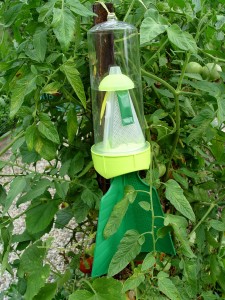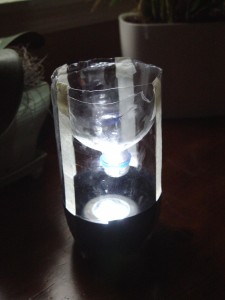Stink Bug Weapons
September 14th, 2011
It’s turning into all-out warfare now.
The brown marmorated stink bug, that Asian import that’s tormented central Pennsylvanians for about a decade now, is obviously not going away.
It’s a bug still swelling in population and now clearly a serious plant pest in addition to being a bug that invades our homes in winter.
Entomologists are saying this stink bug has the potential to become the worst buggy offender in our lifetime.
Scientists are working on a variety of specific pheromone scents that might have the potential to lure in this particular trouble-maker. Specificity is important because there are at least 300 species of stink bugs, and most of them are either neutral or beneficials that keep other pest bugs under control.
Scents are useful both for monitoring populations and for trapping.
Researchers at the U.S. Department of Agriculture also are studying a promising Asian wasp that seems to target only the brown marmorated stink bug. This wasp controls this stink bug in its native range and does so by laying its eggs inside stink-bug eggs. In other words, it’s a parasite.
In its adult life, the wasp feeds mainly on nectar. It sounds promising, but the challenge is making sure it doesn’t do anything unexpected or detrimental before we go releasing it everywhere.
In the meantime, stink-bug-plagued central Pennsylvanians are faced with the question of what to do now.
Several new weapons have emerged to fight the stink-bug battle. It’s too early to tell yet how effective they’ll all be, but at least here are your options:
Kill Them
Stink bugs congregate on sunny sections of homes as they search for openings inside. Option 1 is to kill them before they find a chink in your armor.
One local reader tells of success spraying swarming stink bugs with hot, soapy water – one part dish soap to two-thirds water. Don’t go too strong or you’ll injure nearby plants. Go too weak and all you’ll end up with is very clean stink bugs. Test a small area first so you don’t stain or damage anything.
A new product from Virginia-based St. Gabriel Organics uses all-natural wintergreen, rosemary, thyme and cinnamon oils to smother stink bugs.
St. Gabriel’s Alex Reuter says you have to hit the bugs with it, and when you do, the spray usually drops them in about a minute. The side effect is that the minty smell counteracts any stinking the bugs attempt to do via their “stink gland.”
The company’s Stink Bug Killer sells for about $16 a bottle at some Agways and Ace and True Value Hardware stores. More information: www.stgabrielorganics.com.
Insecticides containing bifenthrin, cyfluthrin, deltamethrin, insecticidal soap, neem oil and pyrethrins are all labeled for stink-bug control outside. None are recommended for use inside.
You could also hire a pro to do a perimeter spray using those or additional pro-only chemicals. Timing is important to get any protective in place before the bugs get inside. And don’t expect even the latest chemicals like the newly approved dinotefuran to eliminate all stink bugs. At best you’ll sharply knock down the infestation you otherwise might’ve had.
Potential down side to sprays: If doused bugs don’t die until after they get inside, then you’ve got stinky dead stink bugs in your house or walls. Entomologists also are concerned about over-using insecticides that could kill off potential beneficials at a faster rate than the stink bugs.
Block Them
This is probably your best overall option – if you can pull it off.
Look for cracks and openings where stink bugs are getting inside, then seal them off with caulk. The bugs typically play “follow the leader…” when one finds an opening, others go the same route.
Key spots to check: under window sills, cracks around doors and windows, openings around pipes and wires, holes in screens, and around window air conditioners. Air conditioners are best removed for winter.
Sometimes all the bugs are getting via a single opening. So if you can find that and seal it, you might make it easier for them to go look for a crack in your neighbor’s house.
Intercept Them
Sterling International, maker of the Rescue brand of bug traps, debuted an outdoor Stink Bug Trap in July designed to capture stink bugs before they get inside. These plastic dome traps use pheromone scents to lure stink bugs.
They sell for about $20 at most garden centers and home centers.
Sterling’s Stephanie Cates says they’re best placed near stink-bug-favorite plants during the growing season, then moved to about 10 or 15 away from the house as stink bugs look for winter shelter (i.e. now). The attractant range is listed as 30 feet.
Placement seems to be very important as well as exactly how you mount these traps. The company’s web site has several pages full of instructions and photos. Try moving or refitting your trap if you try it and get nothing at first. You might also not get much action until your bugs reach a life stage where they become more interested in that hormonal scent.
Also new is the $16 Bonide Stink Bug Trap (www.bonide.com), which uses a pheromone scent attractant to lure stink bugs into the trap. The scent is supposedly effective for 50 feet and lasts for four weeks.
If stink bugs get inside your house anyway, Rescue traps convert to indoor versions by retrofitting with a blue LED light (about $18 for that kit). The bugs dehydrate inside, and when the trap is full, you dump the dead bugs in a bag or flush them down the toilet.
“Definitely use one in the attic,” says Cates. “What you see in the living space is only a fraction of what you have in the attic.” More information: www.rescue.com.
The Bonide traps also are labeled for indoor use. Rather than converting to light, they use the same pheromone lures.
Capture Them Inside
If all of the above fails, you’re down to capturing them inside. This is a better way to go than trying to bug-bomb or spray your kitchen.
For one thing, you don’t want to poison yourself or your food. For another, having dead stinkbugs in the house attracts carpet beetles, which then can do more interior damage than the mere psychological torment of stink bugs.
One side option is to try and seal any openings where you see stink bugs emerging from the ceiling or walls. At least you’ll keep them out of your living areas.
The low-tech, high-patience way to deal with indoor stink bugs is to place a container of soapy water under a stink bug and disturb it. It’ll usually fly straight down into the water.
When you get tired of that after drowning your 2,000th stink bug, it’s time to move onto indoor traps.
Besides the convertible Rescue trap, two new commercial indoor traps have hit the market.
One is Strube’s Stink Bug Trap, a lighted, hanging plastic, soda-bottle-like trap with holes that uses a plant-based scent lure and “gooey glue” to capture attracted stink bugs.
It was invented by Andy Strube of Lancaster County, who came up with the design after his home near Columbia was inundated by stink bugs.
He says the sticky sleeve can capture 300 bugs in a few days. Toss that when full and get a replacement sleeve.
Strube also says he’s found that his warm light attracts stink bugs better than cool LED or fluorescent lights that other traps use.
The Strube traps are $55 online ($47 at his new store, dubbed “Stink Bug Central,” on North Third Street, Columbia). Replacement sleeves are about $10. More information: www.stinkbugtrapsonline.com.
The second new trap is the “Original Indoor Stink Bug Trap” from Exton-based nth Solution.
This $35 trap uses a light and a “secret sauce” to make what looks like a big, glowing votive, partly filled with liquid.
The light attracts stink bugs, and the irresistible scent of the sauce compels them to dive in. The liquid film that results from the dunking suffocates them. The company says that its goal is “Ex-Stink-tion” of this pest. Give them 2 points for a clever phrase.
The kit comes with enough liquid for 10 or 12 refills, and it’s available at a growing number of independent garden centers and hardware stores. More information: www.indoorstinkbugtrap.com.
Finally, make your own trap using a 2-liter soda bottle, some tape and a $6 battery-operated Sylvania Dot-It LED light from the home center.
A stink-bug-plagued fellow from western Pennsylvania named Julian Smith came up with a design in which he cuts the top off the bottle (he prefers Pepsi), inverts it upside down into the body like a funnel and attaches little “masking tape ladders” to the outside. The light goes in the bottom.
Smith’s how-to video is online at www.youtube.com/watch?v=VwUuHhWYvDA.
A few other stink-bug factoids:
- The brown marmorated stink bug has now spread to more than 30 states and has the potential to survive in all 50.
- An interesting description of what stink bugs smell like when disturbed: a combination of cilantro and burnt rubber. Maybe. It’s distinctive but hard to describe.
- Farmers have seen as much as 50 to 70 percent crop damage done by stink bugs.
- The latest estimate on number of plant species brown marmorated stink bugs will eat: 300 and counting. Like the Japanese beetle, it’s almost easier to list what they might not eat instead of listing what they do.
- Bug experts originally thought we’d see just one generation of brown marmorated stink bugs per year. Now it appears they’re capable of producing two or even three generations in our climate and up to five generations a year in the warmest U.S. zones.
- Stink bugs can fly short distances, but they spread to new areas mainly on cars, planes and in packing/shipping materials.











